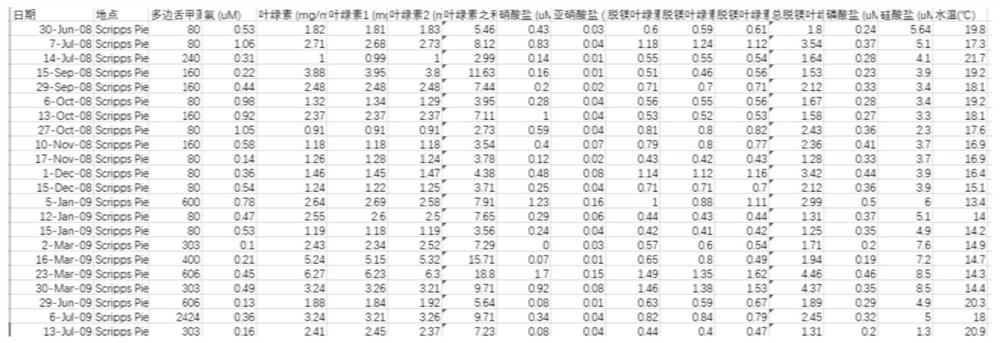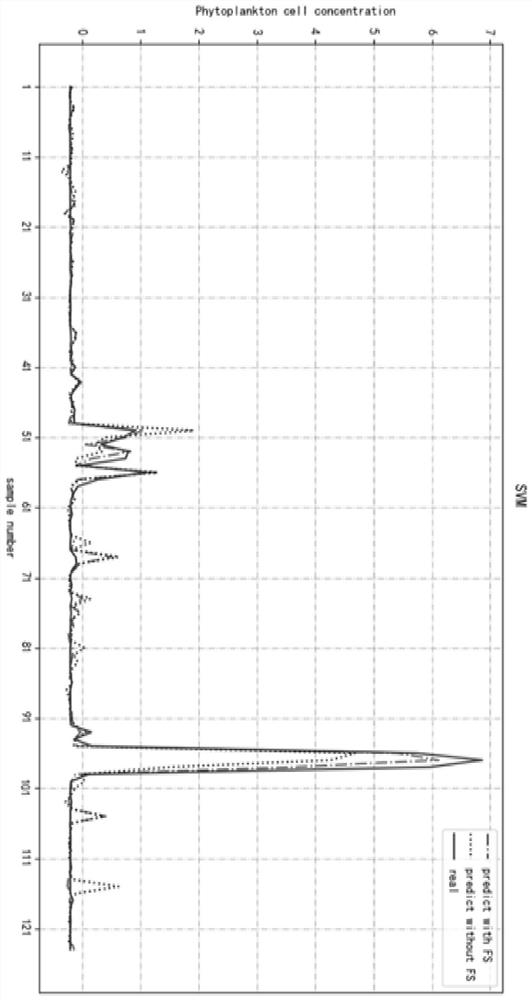Method and system for the analysis of the cause of marine algae and its concentration prediction based on machine learning
A machine learning and concentration prediction technology, applied in machine learning, instrumentation, informatics, etc., can solve problems such as inability to reflect correlation, achieve the effect of improving generalization and ensuring training speed
- Summary
- Abstract
- Description
- Claims
- Application Information
AI Technical Summary
Problems solved by technology
Method used
Image
Examples
Embodiment 1
[0044] This embodiment provides a method for analyzing the cause of marine algae and predicting its concentration based on machine learning, to find out the factors affecting the occurrence of harmful algal blooms, and to predict the concentration of algal cells in the water body.
[0045] Please refer to the attached figure 1 , the method for analyzing the cause of formation of marine algae based on machine learning and the concentration prediction method comprises the following steps:
[0046] S101. Obtain data including algae cell concentration and environmental parameters related to the concentration, and construct a data set.
[0047]Specifically, a large amount of data measured by the ocean observation system includes algae cell concentration data, and each algae cell concentration corresponds to a set of environmental parameters, including water temperature, ammonia, chlorophyll, nitrite, silicate, etc. Using all the algae cell concentration data and the environmental ...
Embodiment 2
[0097] The present embodiment provides a machine learning-based marine algae cause analysis and concentration prediction system, the system comprising:
[0098] The data acquisition module is used to obtain a large amount of algae cell concentration data and concentration-related environmental parameters, construct a data set, and standardize it, and divide the processed data set into a training set and a test set;
[0099] The optimal prediction model selection module is used to perform feature selection on the environmental parameters in the training set to obtain a variety of feature subsets, and perform multiple 10-fold cross-validation on all feature subsets on a variety of different machine learning algorithms to obtain each The optimal feature subset corresponding to the machine learning algorithm and its evaluation index; compare the evaluation indexes of all machine learning algorithms, select the machine learning algorithm with the best evaluation index as the optimal p...
Embodiment 3
[0103] This embodiment provides a computer-readable storage medium on which a computer program is stored, and it is characterized in that, when the program is executed by a processor, the following figure 1 The steps in the machine learning-based method for analyzing the cause of marine algae and predicting its concentration are shown.
PUM
 Login to View More
Login to View More Abstract
Description
Claims
Application Information
 Login to View More
Login to View More - R&D
- Intellectual Property
- Life Sciences
- Materials
- Tech Scout
- Unparalleled Data Quality
- Higher Quality Content
- 60% Fewer Hallucinations
Browse by: Latest US Patents, China's latest patents, Technical Efficacy Thesaurus, Application Domain, Technology Topic, Popular Technical Reports.
© 2025 PatSnap. All rights reserved.Legal|Privacy policy|Modern Slavery Act Transparency Statement|Sitemap|About US| Contact US: help@patsnap.com



